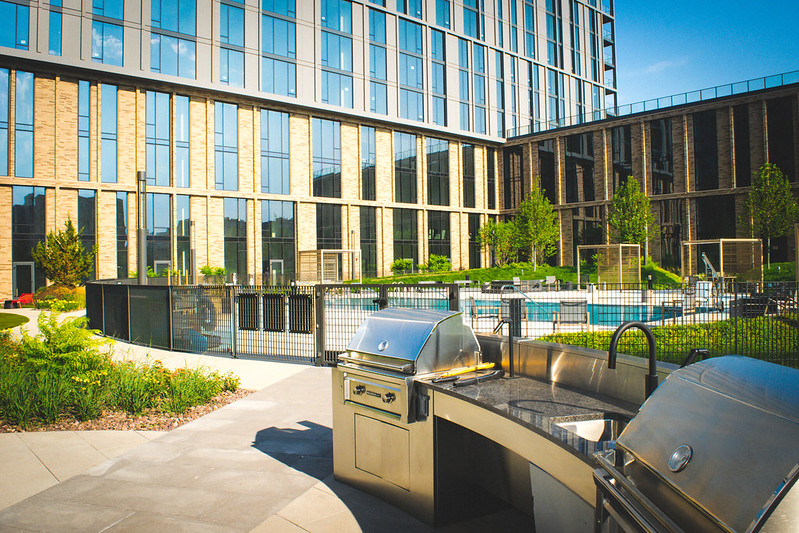“Connection” is among the top offerings at Porte (855 W. Madison St.), a block-sized mega-apartment complex that opened this month in the West Loop.
Usually that’s developer-speak for free Wi-Fi, but in this case it means frequent opportunities to socialize with neighbors in shared spaces like coworking tables, dining rooms, and even a one-acre rooftop deck. It’s “a community at your doorstep,” Porte’s website proclaims.
Sorry, Sartre, Hell is not other people. Just ask luxury developers.
“From the beginning, Porte has been designed around the concept of community. And in the world today, a sense of community may be more important than it’s ever been,” says Chuck Wagener, principal of The John Buck Company, which is co-developing Porte.
They have the numbers to back it up. The 2018 Consumer Housing Insights Survey found that 68 percent of young renters believe that “connecting with people face to face” is an important housing feature. Or, as CBRE's Amenities for the 2020s report put it, “community is the new amenity.”
It’s true — the promise of forging human connection is the newest salvo in the amenities war. It’s no longer enough to give tenants in multifamily residential developments access to rooftop decks, grills, gyms, pools, and coworking spaces. The key is to get them to use those spaces together, through activities and interest groups: fitness and cocktail-making classes, book clubs, and open mics, for instance.
Kenect in Nashville has a podcast recording studio, Treehouse in Los Angeles has community dinners, and The Duncan, which recently opened in the West Loop, is planning movie nights in an outdoor courtyard with food trucks. Meanwhile, Porte boasts a mix of virtual and in-person events, such as outdoor yoga, grilling classes, and a “Wine Down Wednesday” pop-up in the lobby.
Some architects and developers are calling this intentional community-building “the Cheers effect.” In other words, renters are searching for a place where everybody knows your name. Those with one friend in a building are 75 percent likely to resign their lease, and that number increases to 90 percent with two friends, says Jamie Sabat, Director of Trends and Consumer Forecasting with Streetsense and the CBRE study’s co-author.
“It works out for everyone. Residents make friendships and bonds, and [developers] get a high-retention rate,” Sabat says.
Or, at least, that’s the general idea, save for one little complication: The COVID-19 pandemic has put a damper on group events for the foreseeable future. Porte is adapting by putting more activities behind screens, such as an online book club and a mix of live and on-demand fitness classes through Lula-Fit, a “virtual amenities platform.”
“Today’s reality does not change our desire to provide community, camaraderie, and connection at Porte. It simply changes how we are able to provide it,” Wagener says.
So far, COVID-19 doesn’t seem to have stymied demand for community-centered housing. Since pre-leasing began in March, Porte has rented 100 of its 586 units.

Unlike other marketing gimmicks, community-centered housing may have staying power because of shifts in urban social structures over the last several decades. In his 1995 memoir-polemic The Lost City, journalist Alan Ehrenhalt argued that contemporary capitalism and liberalism’s obsession with individual freedom was turning Chicago into a city of neighborhoods without neighbors. The book examined three parts of the metro area that Ehrenhalt had known well: the Catholic church–centric Southwest Side, Black-owned Bronzeville, and the commuter suburb Elmhurst. The midcentury case studies demonstrated how religious roots, strong civic leadership, and even drab middle-class conformity brought social riches.
“It was a life lived in public,” Ehrenhalt wrote.
For many of us, that’s no longer the case. Books like The Lost City and Robert Putnam’s Bowling Alone warned us of this social cohesion deficit decades ago, but it wasn’t treated as a significant problem until recently. Former U.S. surgeon general Vivek Murthy called loneliness a “growing health epidemic” in a 2017 Harvard Business Review essay, citing a study that said social isolation is “associated with a reduction in lifespan similar to that caused by smoking 15 cigarettes a day.” He also argued that addressing loneliness could boost the economy.
Other countries are coming to the same conclusions. A year later, lawmaker Tracey Crouch became England’s first Minister for Loneliness. Meanwhile, Australia established the Coalition to End Loneliness, and France published the report “Fight Social Isolation to Improve Cohesion and Fraternity.” However, the United States government hasn’t responded in kind. The “community as amenity” trend represents a market-based reaction — largely geared towards those who are young, single, and well-off — not a political one.
As such, it’s easy to be skeptical of this kind of commodification of community. At Porte, rents start at $1,960 a month for a 550-square-foot sized apartment. Plus, paying a premium to make friends at a “yappy” — that's a happy hour for dogs, by the way, which Sabat says are becoming a trend — sounds like the kind of thing engineered to make Boomers roll their eyes at Millennials.
These developments also raise the inevitable question: Community for whom? In 2017, when Common, a New York–based company with co-living developments in eight cities, converted Pilsen community center Casa Aztlan into shared apartments — renting from $800 a room — and whitewashed a historic mural, it inevitably drew the ire of residents and activists. Obviously, the irony of yuppies buying their way into a sense of belonging in a neighborhood like Pilsen, with a long history of tight-knit Latino communities, wasn't lost on everyone.
On the other hand, our loneliness epidemic has only gotten worse since the coronavirus ushered in perpetual isolation. Institutions have attempted to address some of the health and economic crises caused by COVID, but not the social ones. Even the most misanthropic among us might have to admit that a book club or grilling food on a deck with friendly neighbors — no matter how contrived the set-up, or how high the price tag — sounds pretty damned good right now.



